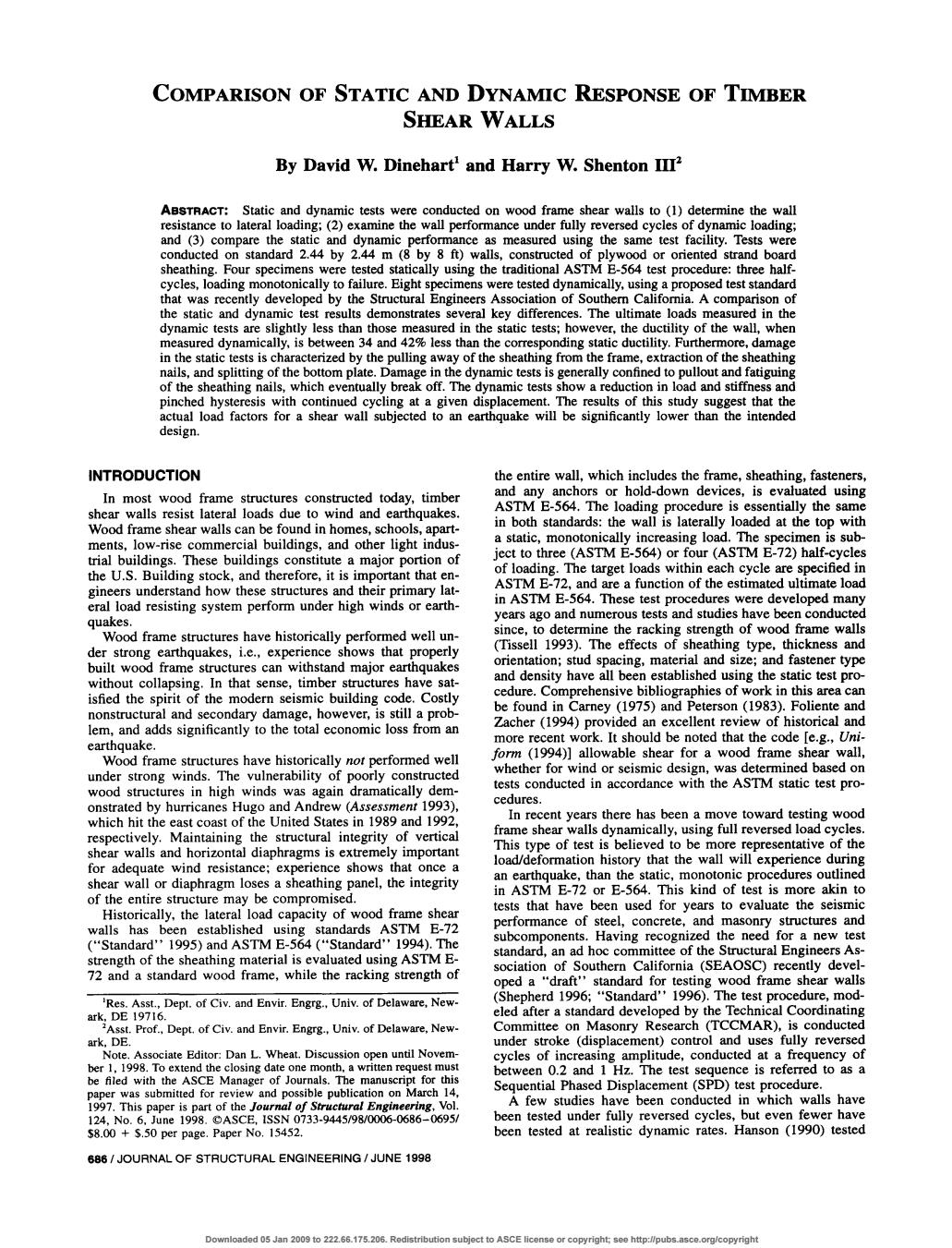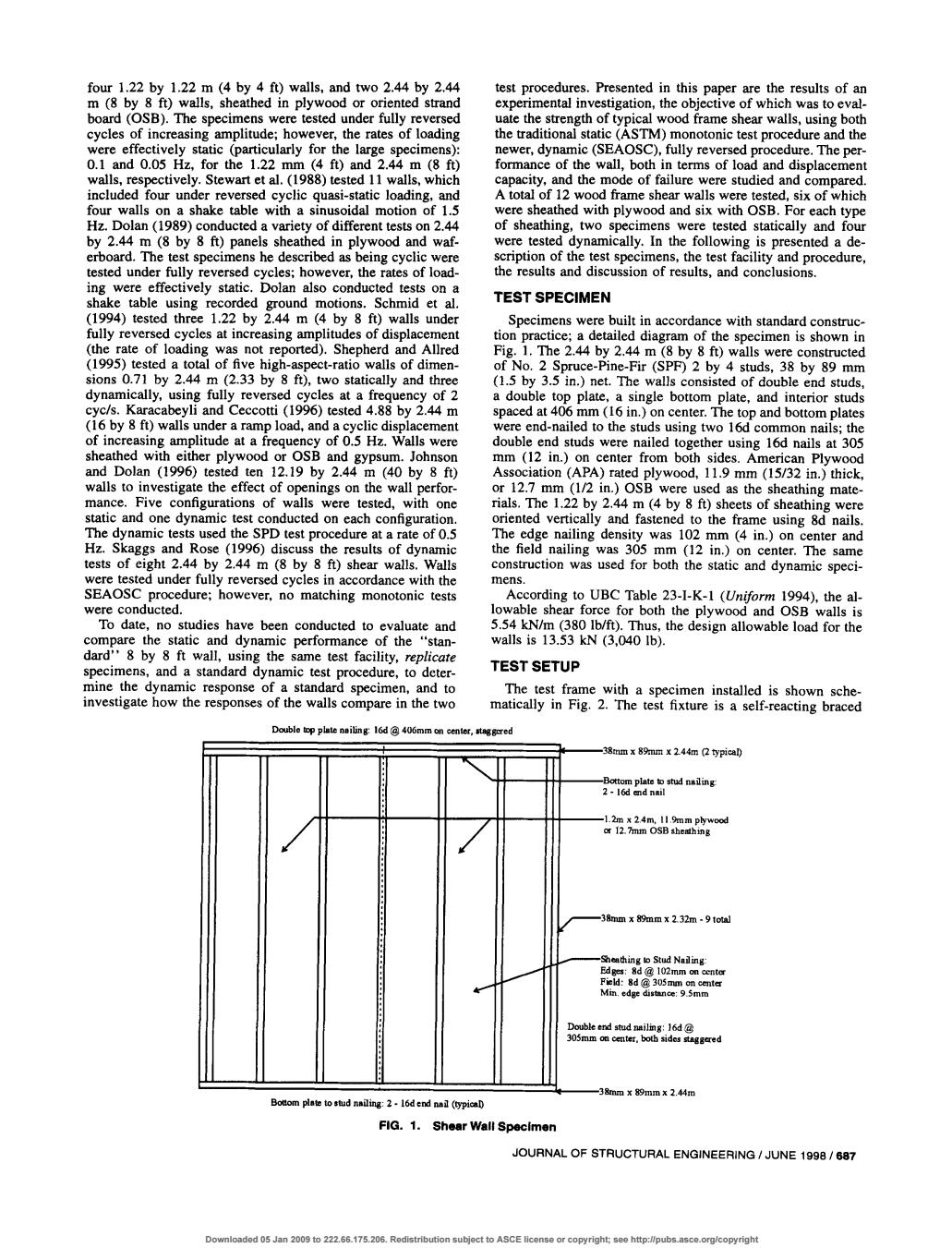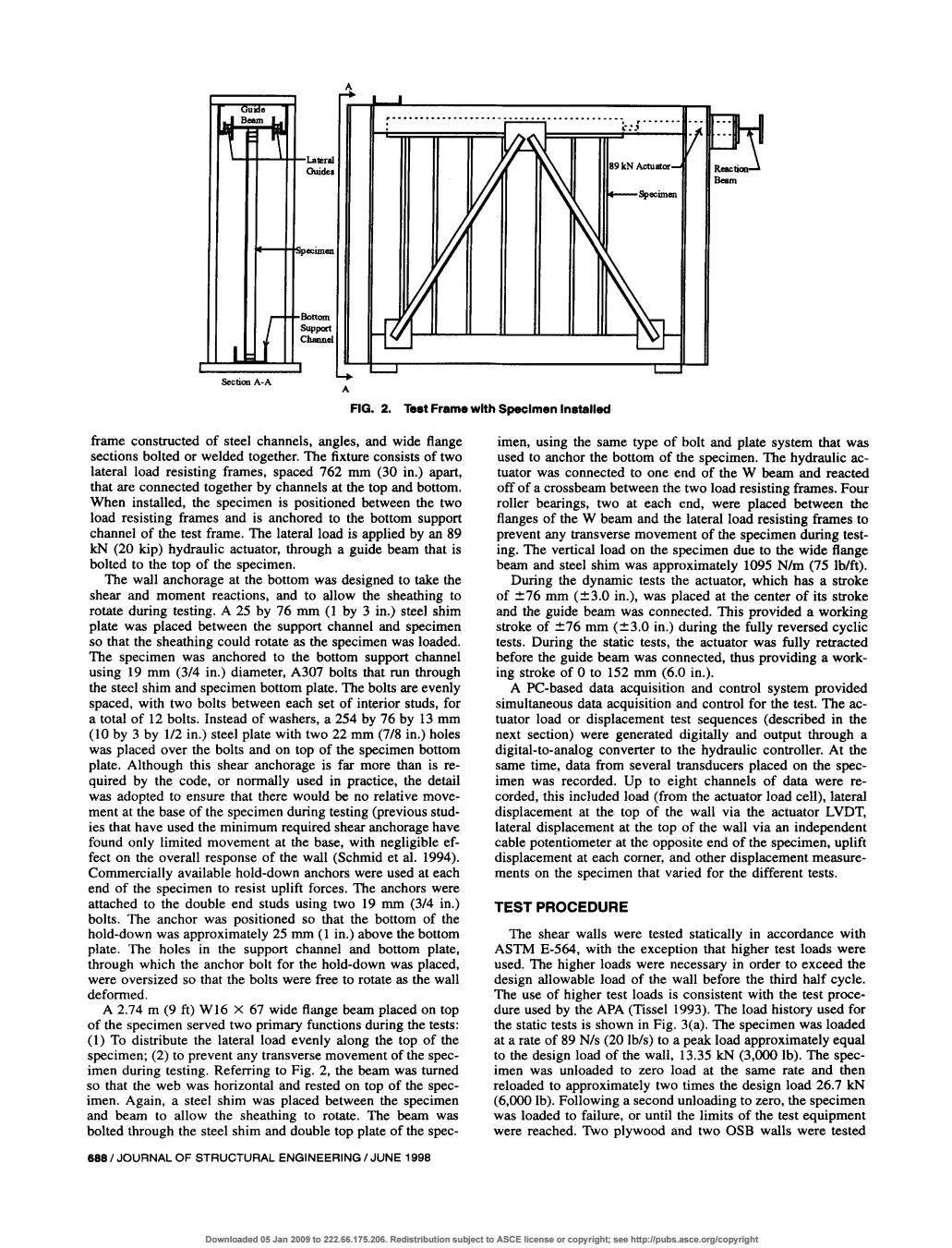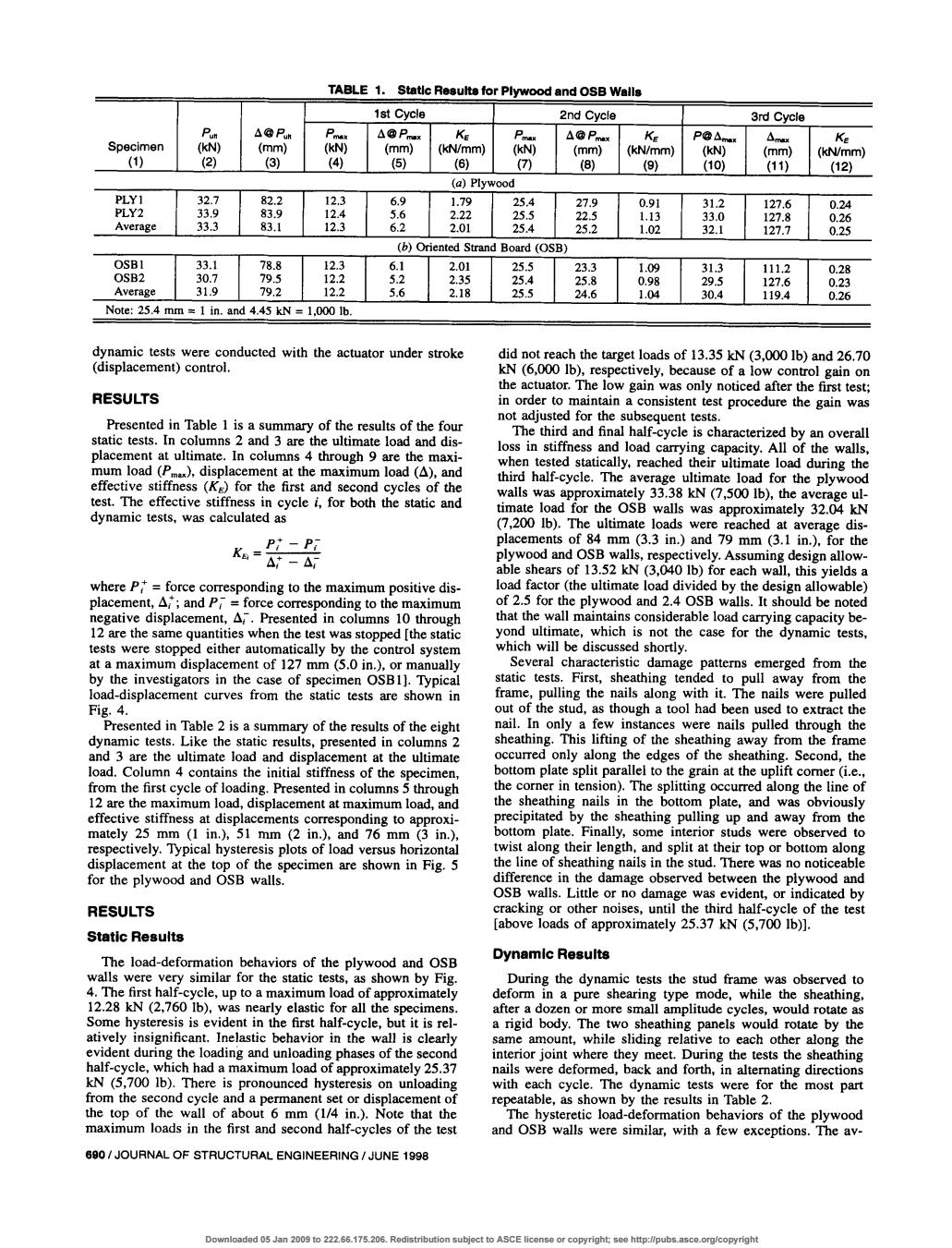
COMPARISON OF STATIC AND DYNAMIC RESPONSE OF TIMBER SHEAR WALLS By David W. Dinehart' and Harry W. Shenton III' ABSTRACT: Static and dynamic tests were conducted on wood frame shear walls to (1) determine the wall resistance to lateral loading; (2) examine the wall performance under fully reversed cycles of dynamic loading; and(3) compare the static and dynamic performance as measured using the same test facility. Tests were conducted on standard 2.44 by 2.44 m (8 by 8 ft) walls, constructed of plywood or oriented strand board sheathing. Four specimens were tested statically using the traditional ASTM E-564 test procedure: three half- cycles, loading monotonically to failure. Eight specimens were tested dynamically, using a proposed test standard that was recently developed by the Structural Engineers Association of Southern Califormia. A comparison of the static and dynamic test results demonstrates several key differences. The ultimate loads measured in the dynamic tests are slightly less than those measured in the static tests; however, the ductility of the wall, when measured dynamically, is between 34 and 42% less than the corresponding static ductility. Furthermore, damage in the static tests is characterized by the pulling away of the sheathing from the frame, extraction of the sheathing nails, and splitting of the bottom plate. Damage in the dynamic tests is generally confined to pullout and fatiguing of the sheathing nails, which eventually break off. The dynamic tests show a reduction in load and stiffness and pinched hysteresis with continued cycling at a given displacement. The results of this study suggest that the actual load factors for a shear wall subjected to an earthquake will be significantly lower than the intended design. INTRODUCTION the entire wall, which includes the frame, sheathing, fasteners, In most wood frame structures constructed today, timber and any anchors or hold-down devices, is evaluated using shear walls resist lateral loads due to wind and earthquakes ASTM E-564. The loading procedure is essentially the same Wood frame shear walls can be found in homes, schools, apart in both standards: the wall is laterally loaded at the top with ments, low-rise commercial buildings, and other light indus- a static, monotonically increasing load. The specimen is sub- trial buildings. These buildings constitute a major portion of ject to three (ASTM E-564)or four(ASTM E-72) half-cycles of loading. The target loads within each cycle are specified in the U.S. Building stock, and therefore, it is important that en- gineers understand how these structures and their primary lat- ASTM E-72, and are a function of the estimated ultimate load eral load resisting system perform under high winds or earth in ASTM E-564. These test procedures were developed many years ago and numerous tests and studies have been conducted quakes. Wood frame structures have historically performed well un since, to determine the racking strength of wood frame walls (Tissell 1993). The effects of sheathing type, thickness and der strong earthquakes, i.e., experience shows that properly built wood frame structures can withstand major earthquakes orientation; stud spacing, material and size; and fastener type without collapsing. In that sense, timber structures have sat- and density have all been established using the static test pro- isfied the spirit of the modern seismic building code. Costly cedure. Comprehensive bibliographies of work in this area can nonstructural and secondary damage, however, is still a prob be found in Carney (1975) and Peterson(1983). Foliente and lem, and adds significantly to the total economic loss from an Zacher(1994) provided an excellent review of historical and more recent work. It should be noted that the code [e.g., Uni- earthquake. Wood frame structures have historically not performed well form (1994)] allowable shear for a wood frame shear wall, under strong winds. The vulnerability of poorly constructed whether for wind or seismic design, was determined based on tests conducted in accordance with the ASTM static test pro- wood structures in high winds was again dramatically dem onstrated by hurricanes Hugo and Andrew (Assessment 1993) cedures. which hit the east coast of the United States in 1989 and 1992 In recent years there has been a move toward testing wood respectively. Maintaining the structural integrity of vertica frame shear walls dynamically, using full reversed load cycles. This type of test is believed to be more representative of the shear walls and horizontal diaphragms is extremely important load/deformation history that the wall will experience during for adequate wind resistance; experience shows that once a an earthquake, than the static, monotonic procedures outlined shear wall or diaphragm loses a sheathing panel, the integrity in ASTM E-72 or E-564. This kind of test is more akin to of the entire structure may be compromised. tests that have been used for years to evaluate the seismic Historically, the lateral load capacity of wood frame shear walls has been established using standards ASTM E-72 performance of steel, concrete, and masonry structures and ("Standard'1995) and ASTM E-564("Standard'1994). The subcomponents. Having recognized the need for a new test standard, an ad hoc committee of the Structural Engineers As- strength of the sheathing material is evaluated using ASTM E sociation of Southern California (SEAOSC) recently devel- 72 and a standard wood frame, while the racking strength of oped a "draft' standard for testing wood frame shear walls 'Res. Asst., Dept. of Civ. and Envir. Engrg., Univ. of Delaware, New (Shepherd 1996; "Standard' 1996). The test procedure, mod- ark,DE19716. eled after a standard developed by the Technical Coordinating 2Asst. Prof., Dept. of Civ. and Envir. Engrg., Univ. of Delaware, New Committee on Masonry Research (TCCMAR), is conducted ark, DE. under stroke (displacement) control and uses fully reversed Note. Associate Editor: Dan L. Wheat. Discussion open until Novem cycles of increasing amplitude, conducted at a frequency of ber 1. 1998. To extend the closing date one month, a written request mus between 0.2 and 1 Hz. The test sequence is referred to as a be filed with the ASCE Manager of Journals. The manuscript for this Sequential Phased Displacement (SPD) test procedure paper was submitted for review and possible publication on March 14 1997. This paper is part of the Journal of Structural Engineering, Vol A few studies have been conducted in which walls have 124. No. 6, June 1998. ©ASCE, ISSN 0733-9445/98/0006-0686-0695 been tested under fully reversed cycles, but even fewer have $8.00+ $.50 per page. Paper No. 15452. been tested at realistic dynamic rates. Hanson(1990) tested 686/JOURNAL OF STRUCTURAL ENGINEERING /JUNE 1998 Downloaded 05 Jan 2009 to 222.66.175.206. Redistribution subject to ASCE license or copyright; see http:/pubs.asce.org/copyrigh
Downloaded 05 Jan 2009 to 222.66.175.206. Redistribution subject to ASCE license or copyright; see http://pubs.asce.org/copyright

1.22 by 122 m (4 by 4)walls,and two 2.44 by 2.4 ted in this re the r m( OSB). Th plywed the e the gth pro nd 0.05 zfo 4 the c (SE (1988)1 failure ed a Fw shake table with tion h ply f sheathi two ood and six by2.4 (8 by 8 ft)pan t and waf In ed of t ng is p its and di and pro f resul effec TEST SPECIMEN 199d wall unde Specimens were built in with rate no 2.4 4m fr)walls 1y ally an in 2 by of do sing y 8 ft)walls d and d and mm (12 ir oth 309 side Ing 16 the ad of walls ed as the d on SpD te the ccts sing &d nail a2.44b 44m results )on center.The sam SEAOSC nc with the men thea副 da n dard8 by 8 ft wall. asing the test facilit TEST SETUP mine the respon a st 8mx8m黑244m位ea灯 mx9mmx232m91o mmxmm美4H Tina:2-16dend nd( FIG.1.Shear Wall Specimer JOURNAL OF STRUCTURAL ENGINEERING/JUNE 1998/687
Downloaded 05 Jan 2009 to 222.66.175.206. Redistribution subject to ASCE license or copyright; see http://pubs.asce.org/copyright

Se:tion A-A rame with Specimen installed wid r30 the c co s at the top and tor of n be es and m s e w be m and the later load resisting bean hat is 10 75h and to o士76 the n) was placed at the cente of its el e fully re 19 A307 bol p thus provid 6.0in The vided e 10 by 3 by 1/2in o disp s(described in the plat vith two tan is ad cel). e re red sh ll(Schmid t 199 ment mes ure of the e 34 The TEST PROCEDURE was (1 in the The shear walls e with on the d th ble load 2.4m9f0w16×67wide ed on wa ng the n of the 20 /s) xim The p Re the nc. un toa ximatel d bet ate Th (6.000bdo the limi of the spe bolted through the steel shim and double top plate of the spec vere reached plywoo and two OSB walls were 688/JOURNAL OF STRUCTURAL ENGINEERING/JUNE 1998 Dowloaded 05 Jan 2009 to 222.66.175.206.Redistribution subject to ASCE license or copyright see http:/pubs.as
Downloaded 05 Jan 2009 to 222.66.175.206. Redistribution subject to ASCE license or copyright; see http://pubs.asce.org/copyright

12001400 a. Static Test Load History 7s 25 50 15 20 60 e1 Time(sec) b.Dynamic Test Displacement History FIG.3.Static and Dynamic Test Protocol 1.0,1.25,151.75,2.0,25,30,35 the cted at of 1 H trol. walls were tested dynamically usingth Sta (1996)1.with the that t山 shea he of tes limitati he final cycles at 4.0> mittee disp that that the funda the ra ME)amplitud of 10 to 20 Hz.(F and Zac 0.75 an ctual ear uake:ate a th ato The chi ved and stil a re the sp at can b ne multipl ME The and ing that Four p Note that the JOURNAL OF STRUCTURAL ENGINEERING/JUNE 1998/68 000o222.66.175.20
Downloaded 05 Jan 2009 to 222.66.175.206. Redistribution subject to ASCE license or copyright; see http://pubs.asce.org/copyright

TABLE 1.Statlc Reeult or Plywood and OSB Wall 2nd Cycle 3rd Cycle 管微的 8s8副 器8 翌 Note:25.4 mm =1 in.and 4.45 kN=1,000 Ib ol s 26.70 RESULTS st procedure the gain was oad c In column -cycle the ply b),tn dynamic tests.was y32.04kN 3.)and 79 mm (.n for the ive dis oad di ided d be case for dy hich n OSBI).Ty from th ext ail r of the ime d,an ipi their lengt line of split at top or shown in Fig. RESULTS Static Results Dynamic Results up to a ma ativcyinsignitcan or in the wall g ive to re deform back and fo rth,n alt T he at alls were simil a few exceptic 600/JOURNAL OF STRUCTURAL ENGINEERING/JUNE 1998 05 Jan 200 to 222.66.175.206.Redistribution subject to ASCE license or copyright see http:/pubs.asce.orglcopyrigh
Downloaded 05 Jan 2009 to 222.66.175.206. Redistribution subject to ASCE license or copyright; see http://pubs.asce.org/copyright